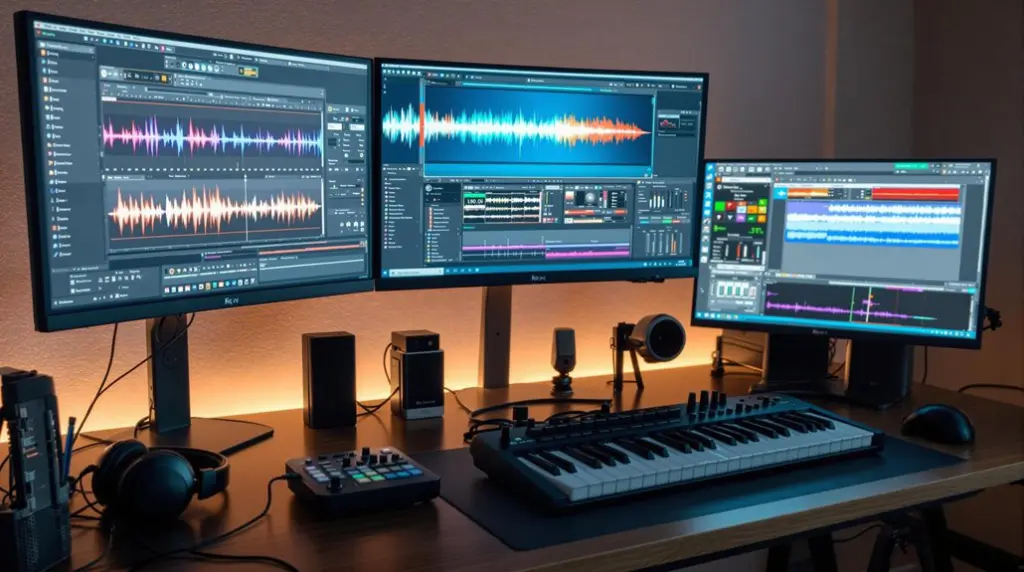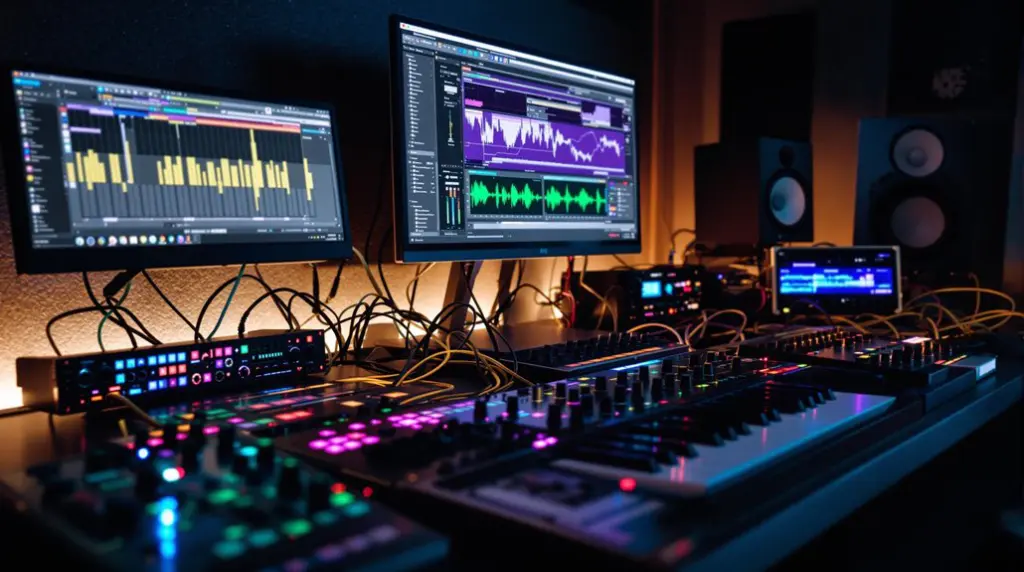In our thorough review of Arturia Pigments VST, five standout features emerge that raise this synthesizer above its peers. Its versatile sound engines, including Wavetable, Granular, and Harmonic, offer dynamic sound creation. The advanced modulation system, with multi-stage envelope generators and random modulation sources, invites intricate sound design. A user-friendly interface highlights functionality with intuitive layout and color-coded elements. Innovative sequencing tools enable complex polyrhythmic patterns and extensive parameter control. Finally, robust community and artist support with regular webinars and active forums provides valuable learning opportunities. Discover more about how these features can transform your music production.
Key Takeaways
- Versatile Sound Engines: Four innovative sound engines (Sample & Granular, Wavetable, Harmonic, Virtual Analog) enable diverse and intricate sound creation.
- Advanced Modulation System: Three LFOs, various envelopes, and a user-friendly modulation grid offer detailed and intuitive sound manipulation.
- Innovative Sequencing Tools: Full-featured sequencer with polyrhythmic patterns and dynamic parameter lanes enhances creative sequencing.
- User-Friendly Interface: Bright, color-coded design with 3D wavetable representation simplifies navigation and enhances user engagement.
- Performance and Compatibility: Low CPU usage, multi-platform support, and high-quality audio output ensure seamless integration and professional performance.
Versatile Sound Engines
How does Arturia Pigments set itself apart as a versatile tool for sound designers and musicians? At its core, Pigments features four robust sound engines—Sample & Granular, Wavetable, Harmonic, and Virtual Analog—each offering distinct synthesis techniques.
The Sample & Granular engine enables intricate sound design through granular controls that manipulate sample playback to create unique textures and atmospheric sounds. This flexibility provides sound designers with the ability to craft highly personalized auditory experiences. In addition, knowledge of signal flow and audio processing can also enhance the use of these engines, ensuring optimal sound quality and creative output.
The Wavetable engine, boasting 164 wavetables including 64 new additions, supports both 2D and 3D visual modulation. This capability allows for intricate and dynamic sound shaping, making it a powerful tool for creating evolving, complex timbres.
Moreover, the Harmonic engine introduces additive synthesis, offering control over 512 partials. This enables the creation of richly layered and evolving sounds, ideal for composers looking to push the boundaries of traditional timbral possibilities.
Virtual Analog synthesis rounds out the quartet, reproducing classic analog sounds with modern precision. The ability to blend these engines together allows users to experiment and innovate, making Arturia Pigments an indispensable resource for both novice and expert sound designers.
Advanced Modulation System
Arturia Pigments’ advanced modulation system stands as a demonstration to its commitment to providing sound designers with unparalleled creative freedom. This sophisticated framework features three LFOs and a variety of envelopes that facilitate intricate sound manipulation. The inclusion of unique function generators allows for additional layers of modulation, catering to the needs of both experimental and traditional sound design.
The intuitive modulation grid, which offers drag-and-drop functionality, simplifies the process of assigning modulation sources to various parameters. Users can seamlessly integrate LFO customization and envelope shaping into their workflow, ensuring thorough control over their sonic creations. The presence of three Random modulation sources, such as Turing and Sample & Hold patterns, introduces an element of organic unpredictability, enhancing the depth and complexity of the resulting sounds.
Color-coded indicators greatly aid in understanding modulation routing, making the system accessible for both novice and experienced users. Arturia Pigments also includes a versatile sound library that encourages experimentation and sound refinement.
The extensive modulation options are further supported by multi-stage envelope generators (MSEGs), which feature up to 64 breakpoints for detailed sound shaping. This extensive array of tools and features positions Arturia Pigments as a formidable VST in the domain of advanced modulation capabilities.
User-Friendly Interface
Building on the advanced modulation system, the user-friendly interface of Arturia Pigments assures that the extensive array of features remains accessible and manageable. The bright and colorful interface enhances user engagement and facilitates intuitive navigation, making it suitable for both novices and seasoned sound designers.
Color-coded design elements play a vital role in tracking changes and modulation, simplifying the often complex process of sound manipulation. One standout aspect is the 3D model representation of wavetables, which provides users with precise control over sound shaping. This feature enriches the visual experience of sound design, allowing for more detailed and accurate adjustments.
Visual cues such as bouncing lines and dynamic knobs further enhance usability by guiding users through the adjustment process, thereby guaranteeing a smooth learning curve despite the VST’s complexity.
Additionally, the high-quality sound processing capabilities guarantee that the output remains professional-grade, meeting industry standards.
The layout of the modulation section is particularly remarkable, showcasing over 20 parameters with color-coded connections. This design allows for easy identification and linkage of modulation sources, contributing to a coherent and streamlined workflow.
Innovative Sequencing Tools
Why settle for ordinary sequencing when you can explore the groundbreaking capabilities of Arturia Pigments‘ innovative sequencing tools?
Arturia Pigments offers a full-featured sequencer that excels in creating complex polyrhythmic patterns. Each parameter lane can be assigned unique lengths, allowing users to craft intricate sequences that break away from standard time signatures. This polyrhythmic flexibility is a boon for those looking to infuse their compositions with a level of complexity often hard to achieve in conventional sequencers.
Additionally, users can leverage dynamic EQ techniques alongside these sequences to manage frequency-specific control, ensuring a balanced and clear mix.
The sequencer’s randomization techniques further enhance its creative potential. Options for randomizing pitch, trigger probability, and gate length provide a fertile ground for spontaneous melody and rhythm generation.
These randomization features are indispensable for artists seeking to add an element of unpredictability and dynamism to their projects. Users can manipulate up to six parameter lanes simultaneously, each with independent settings, offering unparalleled dynamic sequencing possibilities.
The sequencer’s MIDI output support extends its utility, allowing it to control other VST instruments, thereby broadening the creative canvas during both live performances and studio sessions.
Arturia Pigments also includes an intuitive visual modulation overview, simplifying the process of tracking and assigning modulation sources, making it easier to navigate complex sound designs.
Community and Artist Support
As impressive as the innovative sequencing tools of Arturia Pigments are, the support and engagement from the community and artists further enhance its status in the music production landscape. Arturia’s commitment to its user base is evident through its active participation in online forums, where users can exchange tips, discuss features, and share their experiences. This open communication fosters a collaborative environment that benefits both novices and seasoned producers.
The provision of thorough documentation and a plethora of video tutorials underscores Arturia’s dedication to user education. These resources make mastering Pigments’ extensive features more accessible, ensuring users can fully exploit its capabilities. Additionally, regular webinars and workshops hosted by Arturia offer direct learning opportunities from industry experts, enabling users to refine their sound design skills.
User feedback plays a pivotal role in shaping updates and new features for Pigments, demonstrating Arturia’s responsiveness to user needs and preferences. Artist endorsements from notable figures like Jamie Lidell and Howie B further solidify Pigments’ reputation. Their praise for its innovative design and sound creation capabilities highlights its effectiveness and appeal within the music production community.
This dual support from users and artists alike cements Pigments as a leading synthesizer in the industry.
Frequently Asked Questions
What Are Arturia Pigments Good For?
Arturia Pigments excels in sound design, offering versatile synthesis engines and an advanced modulation system. Its user-friendly interface and real-time performance controls enhance workflow efficiency, making it ideal for both beginners and experienced sound designers.
Which Is Better, Pigments or Serum?
Determining whether Pigments or Serum is better depends on user needs. Pigments’ versatility in combining multiple synthesis engines and advanced modulation options contrasts with Serum’s streamlined interface and exceptional wavetable sound design, catering to different creative approaches.
Is Pigments a Good Synth?
Arturia Pigments excels as a synthesizer, boasting extensive synthesis capabilities and diverse sound design options. Its integration of multiple synthesis types and user-friendly interface makes it an invaluable tool for both novice and expert sound designers.
Is Pigment 5 Worth It?
The consensus from user feedback suggests that Pigments 5 is indeed worth it. Enhanced multi-core processing, a user-friendly generative sequencer, and expanded sound design options greatly improve user experience, making it a valuable tool for musicians.
Conclusion
In conclusion, Arturia Pigments VST exemplifies a synthesis instrument of notable versatility and innovation. The diverse sound engines provide a broad sonic palette, while the advanced modulation system guarantees extensive sound-shaping capabilities. The user-friendly interface enhances accessibility for users at varying skill levels. Additionally, the innovative sequencing tools expand creative possibilities, and robust community and artist support fosters a collaborative environment. Collectively, these features solidify Pigments’ status as a powerful and all-encompassing tool for music production.




